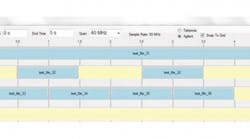This file type includes high resolution graphics and schematics when applicable.
Captured signals that can be digitized, stored, and modified to create different signal sequences of interest are of interest for a wide range of applications, from electronic warfare (EW) to laboratory and field testing of communications and radar systems. Assisting the process substantially is the latest version of the personal-computer (PC)-based RF Editor software from X-COM Systems. This offering allows flexible modifications on signal files of any length, whether captured over the air, offloaded from a signal analyzer, or created in software tools such as MATLAB from The MathWorks. Using as many as 10 independent tracks (see figure), it allows users to trim, join, repeat, lengthen, delay, filter, or shift signals in frequency, and perform many other changes as well.
The capability to modify signal-capture files has significant benefits, but the digital files resulting from monitoring small or even very large swaths of spectrum can be long and occupy terabytes of memory. Consequently, it is necessary to reduce these files to include only those waveforms considered to be signals of interest, which is complicated by the fact that they may occur intermittently or randomly over a long period of time. This task is one of many that can be performed by X-COM’s Spectro-X signal analysis software, which uses four different types of search engines to find the files and then create a new file containing only the desired sections.
Then, the RF Editor software takes over. Since the RF Editor and Spectro-X software are seamlessly integrated, a user need only transfer a file from Spectro-X to RF Editor; it is then modified to the desired degree and can be saved with a single mouse click to create a new, custom waveform file. The file can then be sent back to Spectro-X where it can be used for testing as a stimulus, in EW systems, or even in signal-intelligence (SIGINT) systems.
RF Editor allows functions to be performed both sequentially and automatically, such as frequency shifting, file decimation, and bandpass filtering with bandwidths as narrow as 10% of a waveform segment’s span. Other features include presets for fast frequency shifting and span adjustment, power adjustment with 0.1-dB resolution, and the capability to apply frequency offsets, interference, and noise to produce a wide range of test scenarios—ranging from ideal or theoretical conditions to worst-case scenarios.
Version 3.0 of RF Editor adds new features to earlier versions of the software while also being faster and easier to use. Perhaps the most important of these features, stitching, allows unwanted portions of spectrum-capture files identified in Spectro-X to be eliminated or replaced with data from a different file. The files are then reconnected, producing versions solely with the desired characteristics that are much smaller in memory size.
The new group modify function significantly reduces the time required to modify the attributes of large numbers of signal-capture files, which previously had to be performed individually. The user now simply selects a group of files to be modified, indicates the desired modifications from the many choices provided by RF Editor (such as shifting frequency, resampling, filtering, or changing attenuation or gain), and the software will make the modifications without operator intervention.
The new software also now supports the .xdat file format used by X-COM’s VSG5000A multichannel signal generator and IQC5000A RF capture, recording, and playback system. These files contain much more information than standard .dat files, including markers, center frequency, span, sample rate, date, time, and Global Positioning System (GPS) positional data. RF Editor 3.0 also includes scale factor calibration, which enables modifications to be made to the scale-factor parameter that RF Editor uses to determine signal power in order to add or subtract attenuation or gain without making modifications to the file. RF Editor 3.0 and Spectro-X software are available from X-COM and trial versions of each one are available on the company’s website.
James Taber, Director of Marketing & Sales
X-COM Systems, 12345-B Sunrise Valley Dr., Reston, VA 2019; (571) 612-5490
This file type includes high resolution graphics and schematics when applicable.


